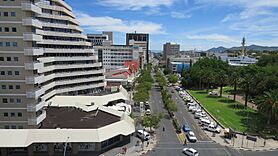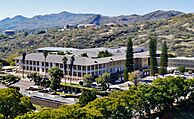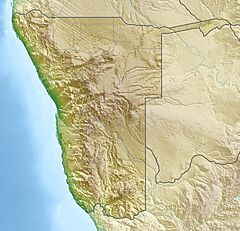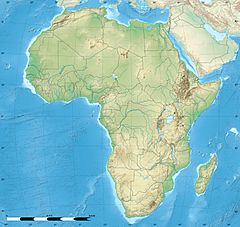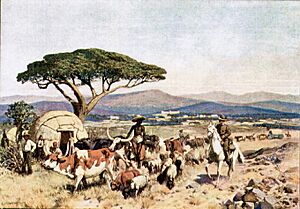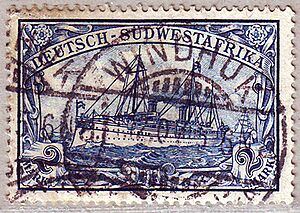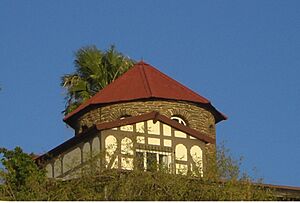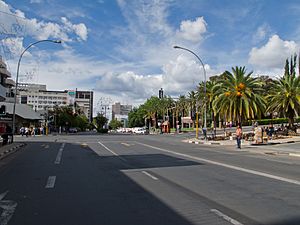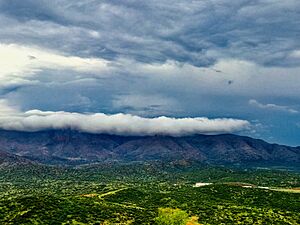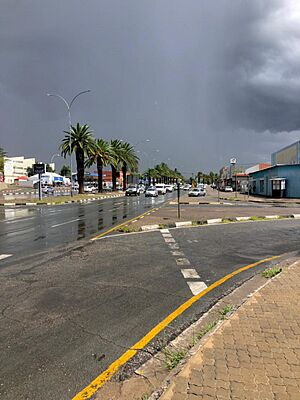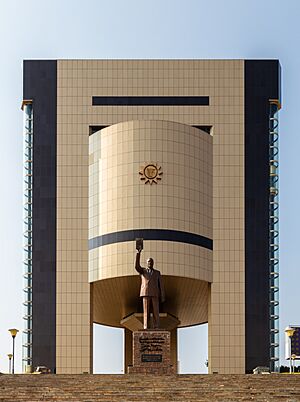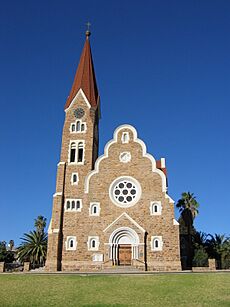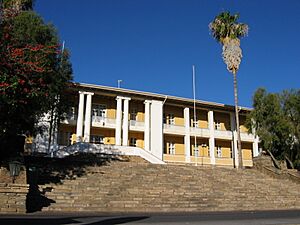Windhoek facts for kids
Quick facts for kids
Windhoek
|
|||
|---|---|---|---|
| City of Windhoek | |||
|
Clockwise from top: Windhoek CBD, Parliament building, Windhoek railway station, State House, Christ Church
|
|||
|
|||
| Motto(s):
Suum Cuique (Latin for 'To each his own')
|
|||
| Country | |||
| Region | Khomas Region | ||
| First settled | 1840 | ||
| Second founding | 18 October 1890 | ||
| Government | |||
| • Type | Mayor-council government | ||
| Area | |||
| • Total | 5,133 km2 (1,982 sq mi) | ||
| Elevation | 1,655 m (5,430 ft) | ||
| Population
(2023 census)
|
|||
| • Total | 486,169 | ||
| • Density | 94.714/km2 (245.309/sq mi) | ||
| Time zone | UTC+02:00 (Central Africa Time) | ||
| • Summer (DST) | (Not Observed) | ||
| Postal code |
10005
|
||
| Area code | 061 | ||
| Climate | BSh | ||
Windhoek is the capital and largest city of Namibia. It is located in the middle of Namibia, in the Khomas Highland plateau area. The city is about 1,700 meters (5,577 feet) above sea level. In 2023, Windhoek had a population of 486,169 people. The city is always growing as more people move there from other parts of Namibia.
Windhoek is the main social, economic, political, and cultural hub of the country. Almost all of Namibia's national businesses, government offices, and educational places are found here.
The city grew around a natural hot spring, which was important to the local tribes. It started to develop quickly after Jonker Afrikaner, a leader of the Orlam people, settled there in 1840. He built a stone church for his community. Later, wars caused the settlement to be neglected. Windhoek was founded a second time in 1890 by Major Curt von François of the Imperial German Army. This happened when the area became a German colony.
Contents
History of Windhoek
How Windhoek Got Its Name
There are different ideas about how Windhoek got its name. Many people think it comes from the Afrikaans words wind (meaning wind) and hoek (meaning corner). Another idea is that Captain Jonker Afrikaner named it after the Winterhoek Mountains in South Africa, where his family used to live. The name Windhoek was first written in a letter from Jonker Afrikaner in 1844.
Early Days of Settlement
In 1840, Jonker Afrikaner created a settlement for the Orlam people in Windhoek. They lived near one of the main hot springs. He built a large stone church that could hold 500 people and was also used as a school. Missionaries came to work there, but later left. Gardens were planted, and for a while, Windhoek did well. However, wars between the Nama and Herero tribes eventually destroyed the settlement. Years later, a botanist found only wild animals and neglected fruit trees there.
The Colonial Era
In 1884, Germany declared the area, now called Namibia, a German protectorate. This happened after merchants from Lüderitzbucht asked for protection. In 1890, Germany sent soldiers, led by Major Curt von François, to keep order. Von François set up his base in Windhoek because it was a good spot between the warring Nama and Herero groups. The twelve strong springs provided plenty of water.
Colonial Windhoek was officially founded on October 18, 1890. This is when von François laid the first stone of the fort, now known as the Alte Feste (Old Fortress). After 1907, the city grew faster as people moved from the countryside to find work. More European settlers also arrived. Businesses opened on Kaiser Street (now Independence Avenue). During this time, Windhoek's three famous castles – Heinitzburg, Sanderburg, and Schwerinsburg – were built.
South African Rule After World War I
The German colonial period ended after World War I. Windhoek had already been taken over in 1915. After the war, in 1920, the area was managed by South Africa under a League of Nations agreement.
After World War II, more money became available to improve the economy. From 1955 onwards, many big public projects started. These included building new schools and hospitals, paving roads, and building dams to ensure a steady water supply. In 1958, the city started using a special plant that cleaned recycled sewage water so well it could be used for drinking. This was the first plant of its kind in the world.
Windhoek officially became a town on October 18, 1965. This was to celebrate 75 years since its second founding by von François. In 1971, a big strike by workers started in Windhoek. They wanted to end the contract labor system and fight against apartheid, hoping for Namibia's independence.
Windhoek Since Independence
Since Namibia became independent in 1990, Windhoek has remained the capital. It is also the main city of the central Khomas Region. After independence and the end of conflicts, the city has grown and developed very quickly.
Windhoek's Economy
Windhoek is the main administrative, business, and industrial center of Namibia. A study in 1992-1993 showed that Windhoek provides more than half of all non-farming jobs in Namibia. It has a very high share of jobs in utilities, transport, communication, finance, and business services. Because of its size, Windhoek is the most important social, economic, and cultural center in the country. The University of Namibia is here, along with almost all national businesses, government offices, and major media and financial companies.
Getting Around Windhoek
Road Transport
Windhoek's three main roads, coming from Rehoboth, Gobabis, and Okahandja, are paved. They are built to handle very large floods. These paved roads allow traffic to move at 120 kilometers per hour (75 mph) and are designed to last for 20 years.
In 1928, Kaiserstraße, now called Independence Avenue, was the first paved road in Windhoek. Ten years later, Gobabis road, now Sam Nujoma Drive, was also paved. Today, about 5,000 kilometers (3,100 miles) of Namibia's total road network are paved.
In 2014, plans were made to make the Windhoek-Okahandja road a dual carriageway (a road with two separate lanes in each direction). This project was expected to cost about N$1 billion. There were also plans to upgrade the road to Hosea Kutako International Airport to a dual carriageway.
Public transport like buses is not very common in Windhoek. Most people get around by taxi. In 2013, there were 6,492 registered taxis in the city.
Air Travel
Windhoek has two airports. Eros Airport is about 7 kilometers (4.3 miles) south of the city center and is used for smaller planes. Hosea Kutako International Airport is 42 kilometers (26 miles) east of the city and handles larger flights. Many international airlines fly to and from Windhoek. You can also rent air charters, helicopters, and planes.
Hosea Kutako International Airport serves over 800,000 passengers each year. It has one runway that can handle many flights. Other international airports in Namibia are in Walvis Bay, with smaller domestic airports in Lüderitz, Oranjemund, and Ondangwa.
Eros Airport is the busiest airport in Namibia for takeoffs and landings. This city airport handles about 150 to 200 flights daily, totaling around 50,000 per year. Most of Namibia's charter flight companies are based at Eros.
Rail Connections
Windhoek is connected by train to:
- Okahandja (north)
- Rehoboth (south)
- Gobabis (east)
Windhoek's Geography
Expanding Windhoek has been difficult due to its location. To the south, east, and west, the city is surrounded by rocky, mountainous areas. This makes building new developments very expensive. The southern side is also not good for factories because of underground water sources. This means the large Brakwater area north of the city is the best place for Windhoek to grow.
The city council plans to greatly expand Windhoek's boundaries. The city area would then cover 5,133.4 square kilometers (1,982 square miles). This would make Windhoek one of the largest cities in the world by area, even though its population density is only 63 people per square kilometer.
City Suburbs
Windhoek is divided into many suburbs and townships. Some of these include:
- Academia
- Auasblick
- Avis
- Cimbebasia
- Dorado Park
- Donkerhoek
- Elisenheim
- Eros
- Eros Park
- Freedom Land
- Goreangab
- Groot Aub (since September 2017)
- Greenwell Matongo
- Hakahana
- Havana
- Hochland Park
- Katutura
- Khomasdal
- Kleine Kuppe
- Klein Windhoek
- Lafrenz Industrial Area
- Ludwigsdorf
- Luxury Hill (Luxushügel)
- Maxuilili
- Northern Industrial Area
- Okuryangava
- Olympia
- Ombili
- Otjomuise
- Pionierspark
- Prosperita
- Rocky Crest
- Southern Industrial Area
- Suiderhof
- Tauben Glen
- Wanaheda
- Windhoek Central
- Windhoek North
- Windhoek West
In many of Windhoek's townships, people live in informal homes called shacks. In 2020, the city had 41,900 of these homes, where nearly 100,000 people lived.
Windhoek's Climate
Windhoek enjoys over 300 sunny days each year. It has a hot semi-arid climate, meaning it's generally warm and dry. The average temperature throughout the year is mild because of the city's high altitude. The difference between the average high and low temperatures is about 13.4°C (24.1°F). July is the coldest month, with an average temperature of 13.1°C (55.6°F). December is the hottest month, with an average temperature of 23.5°C (74.3°F).
Because it's near the Kalahari Desert, Windhoek gets a lot of sunshine, about 3,605 hours a year. Most of the rain falls during the summer, while winters are very dry. The city gets an average of 367.4 mm (14.46 inches) of rain each year.
| Climate data for Windhoek (1728 m), Namibia | |||||||||||||
|---|---|---|---|---|---|---|---|---|---|---|---|---|---|
| Month | Jan | Feb | Mar | Apr | May | Jun | Jul | Aug | Sep | Oct | Nov | Dec | Year |
| Record high °C (°F) | 36.0 (96.8) |
35.8 (96.4) |
34.9 (94.8) |
31.3 (88.3) |
31.8 (89.2) |
26.1 (79.0) |
25.7 (78.3) |
30.0 (86.0) |
33.2 (91.8) |
35.1 (95.2) |
36.5 (97.7) |
36.6 (97.9) |
36.6 (97.9) |
| Mean daily maximum °C (°F) | 30.0 (86.0) |
28.6 (83.5) |
27.2 (81.0) |
25.6 (78.1) |
22.7 (72.9) |
20.2 (68.4) |
20.5 (68.9) |
23.4 (74.1) |
26.5 (79.7) |
29.1 (84.4) |
29.6 (85.3) |
30.7 (87.3) |
26.1 (79.0) |
| Daily mean °C (°F) | 23.3 (73.9) |
22.1 (71.8) |
21.0 (69.8) |
18.9 (66.0) |
15.8 (60.4) |
13.2 (55.8) |
13.1 (55.6) |
15.8 (60.4) |
19.3 (66.7) |
21.7 (71.1) |
22.5 (72.5) |
23.5 (74.3) |
19.1 (66.4) |
| Mean daily minimum °C (°F) | 17.2 (63.0) |
16.5 (61.7) |
15.4 (59.7) |
12.8 (55.0) |
9.2 (48.6) |
6.7 (44.1) |
6.3 (43.3) |
8.6 (47.5) |
11.9 (53.4) |
14.6 (58.3) |
15.6 (60.1) |
16.9 (62.4) |
12.7 (54.9) |
| Record low °C (°F) | 7.5 (45.5) |
6.8 (44.2) |
3.7 (38.7) |
2.4 (36.3) |
−1.6 (29.1) |
−2.8 (27.0) |
−2.6 (27.3) |
−3.9 (25.0) |
−1.1 (30.0) |
1.6 (34.9) |
0.4 (32.7) |
3.3 (37.9) |
−3.9 (25.0) |
| Average precipitation mm (inches) | 78.1 (3.07) |
80.3 (3.16) |
78.7 (3.10) |
37.7 (1.48) |
6.6 (0.26) |
1.2 (0.05) |
0.7 (0.03) |
0.9 (0.04) |
2.8 (0.11) |
11.8 (0.46) |
26.9 (1.06) |
41.7 (1.64) |
367.4 (14.46) |
| Average precipitation days (≥ 0.1 mm) | 11.1 | 10.7 | 10.5 | 5.5 | 1.9 | 0.7 | 0.5 | 0.3 | 0.9 | 2.8 | 5.3 | 7.5 | 57.7 |
| Average relative humidity (%) | 42 | 56 | 51 | 44 | 37 | 32 | 27 | 19 | 17 | 22 | 30 | 34 | 34 |
| Mean monthly sunshine hours | 288 | 254 | 282 | 273 | 310 | 309 | 326 | 341 | 321 | 319 | 297 | 285 | 3,605 |
| Source 1: Deutscher Wetterdienst | |||||||||||||
| Source 2: Danish Meteorological Institute (sun only) | |||||||||||||
Population of Windhoek
In 1971, there were more white residents (about 26,000) than black residents (about 24,000) in Windhoek. About a third of the white residents spoke German. As of 2020, Windhoek has a population of 431,000 people. The population is growing by about 4% each year, partly because more people are moving into informal settlements, which have even higher growth rates. In daily life, Afrikaans and, to a lesser extent, German are still commonly spoken, even though the government uses only English.
| Historical population | ||
|---|---|---|
| Year | Pop. | ±% p.a. |
| 1981 | 96,057 | — |
| 1991 | 147,056 | +4.35% |
| 2001 | 233,529 | +4.73% |
| 2011 | 325,858 | +3.39% |
| 2016 | 395,000 | +3.92% |
| 2023 | 486,169 | +3.01% |
| source: | ||
Windhoek's Culture
Windhoek is known as the art capital of Namibia. The National Art Gallery, National Theatre, and the National Museum are all located here. The National Museum has two parts: the Alte Feste (Old Fortress) shows historical items like old wagons, while the Owela Museum (named after a traditional game) has displays of minerals, fossils, and meteorites, and shows what traditional village life was like. There is also the Independence Memorial Museum, the National Library of Namibia, and the Windhoek Public Library, which was built in 1925.
Places of Worship
Most places of worship in Windhoek are Christian churches. These include churches from the Evangelical Lutheran Church in Namibia, Evangelical Lutheran Church in the Republic of Namibia, and the German-speaking Evangelical Lutheran Church in Namibia. There are also Baptist Convention of Namibia churches, Assemblies of God, and the Roman Catholic Archdiocese of Windhoek. The city also has some Islamic mosques, like the Windhoek Islamic Center.
Famous Buildings and Landmarks
- Alte Feste – This Old Fortress was built in 1890 and now houses the National Museum.
- Curt von François monument – This statue was moved in 2022 and will be kept in the local Windhoek City Museum.
- Heroes' Acre – A national memorial for war heroes, located about 10 km (6 miles) outside the city.
- Independence Memorial Museum (Namibia) – A museum that tells the story of Namibia's fight against colonial rule and for freedom.
- National Council (Namibia) – This is the upper house of Namibia's Parliament.
- Reiterdenkmal (Equestrian Monument) – A statue that was moved in 2013 and is now displayed in the yard of the Alte Feste.
- State House, Windhoek – This is where the President of Namibia lives.
- Supreme Court of Namibia – Built between 1994 and 1996, it is Windhoek's only building designed in an African style after independence.
- The three castles of Windhoek – These were built by architect Wilhelm Sander: Heinitzburg, Sanderburg, and Schwerinsburg.
- Tintenpalast – Meaning Ink Palace, this building is located within Parliament Gardens and is where both parts of the Parliament of Namibia meet. It was built between 1912 and 1913.
- Turnhalle – A classical-style building that opened in 1909.
- Windhoek Railway Station – A historic train station that serves the city.
- Zoo Park – A public park in downtown Windhoek with a pond, playground, and an outdoor theater.
Sports in Windhoek
Rugby union is a very popular sport in Namibia. The men's national team has played in the Rugby World Cup seven times in a row, but they have not yet won a game there. The Welwitschias, a local team, play in South African rugby competitions.
Windhoek has several football (soccer) clubs. These include African Stars F.C., Black Africa F.C., F.C. Civics Windhoek, Orlando Pirates F.C., Ramblers F.C., SK Windhoek, Tigers F.C., Tura Magic F.C., and Citizens F.C.
Many famous boxers, such as Paulus Moses, Paulus Ambunda, and Abmerk Shindjuu, are from Windhoek.
The Namibia national cricket team, called the Eagles, plays most of its home games at the Wanderers Cricket Ground. They also play at other grounds in the city. The team played in the 2003 Cricket World Cup in South Africa.
Men's baseball was first played in Namibia in 1950 at the Ramblers sports club in Windhoek.
The 'Tony Rust Raceway' is a race track located west of Windhoek. Farm Windhoek, owned by the city, is a sports area for hiking, running, and mountain biking.
Education in Windhoek
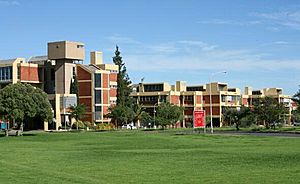
Higher Education Institutions
The main universities and colleges in Windhoek are:
- University of Namibia (UNAM)
- Namibia University of Science and Technology (NUST), which used to be called the Polytechnic of Namibia
- International University of Management (IUM)
Other Learning Places
Other well-known places for higher learning include:
- Institute of Information Technology (IIT)
- College of the Arts (COTA)
Secondary Schools
As of 2016, Windhoek has 29 secondary schools and 58 primary schools. Some of the notable secondary schools are:
- A. Shipena Secondary School
- Academia Secondary School
- Augustineum Secondary School
- Centaurus High School
- Concordia College
- Cosmos High School
- Chairman Mao Zedong High School
- Dagbreek School for the Intellectually Impaired
- David Bezuidenhout Secondary School
- Delta Secondary School Windhoek (DSSW)
- Deutsche Höhere Privatschule (DHPS)
- Ella du Plessis High School
- Eros School for Girls
- Hage Geingob High School
- Holy Cross Convent School
- Immanuel Shifidi Secondary School
- Jakob Marengo Secondary School
- Jan Jonker Afrikaner High School
- Jan Möhr Secondary School
- Saint George's Diocesan College
- Pionier Boys' School
- Saint Paul's College
- Windhoek Afrikaanse Privaatskool (WAP)
- Windhoek Gymnasium Private School (WHK Gym)
- Windhoek High School (WHS)
- Windhoek International School (WIS)
Notable People from Windhoek
- Frank Fredericks (born 1967), athlete
- Gisvi (born 1982) Portuguese former footballer
- Max Katjijeko (born 1995) rugby union player for the Tel Aviv Heat
- Michelle McLean (born 1973), Miss Universe 1992
- Quido (Le-Roy Quido Mohamed) (born 1989), rapper
- Peter Shalulile (born 1993), footballer
- Collin Benjamin (born 1978), retired footballer
See also
 In Spanish: Windhoek para niños
In Spanish: Windhoek para niños


